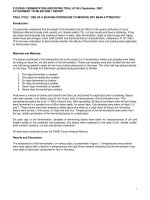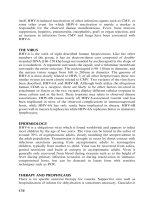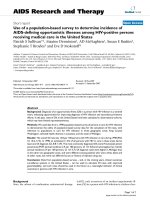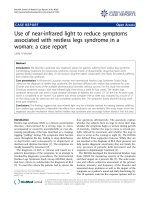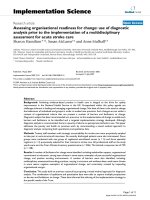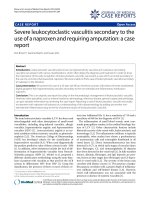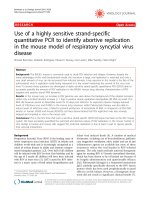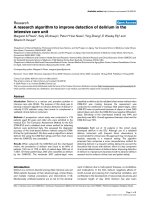USE OF A SOAKING PROCEDURE TO IMPROVE DRY BEAN ATTRIBUTES - MILESTONE 7 pdf
Bạn đang xem bản rút gọn của tài liệu. Xem và tải ngay bản đầy đủ của tài liệu tại đây (104.41 KB, 22 trang )
1
013/VIE05: FERMENTATION AND DRYING TRIAL AT NLU September, 2007.
ATTACHMENT TO MILESTONE 7 REPORT
TRIAL TITLE: “USE OF A SOAKING PROCEDURE TO IMPROVE DRY BEAN ATTRIBUTES”
Introduction:
It is generally understood that the length of fermentation has an effect on the quality attributes of cocoa.
Attributes affected include shell content, pH, titrable acidity (TA), cut test results and flavour attributes. It has
also been demonstrated that soaking of beans in water, after fermentation, leads to dried cocoa with higher
brown bean percentages, lower shell content and improved flavour characteristics, (Hollywood, N. W. 1997).
This trial was undertaken to demonstrate whether the effects of fermentation time and soaking were applicable
to Vietnamese cocoa.
Materials and Methods:
The factors mentioned in the introduction led to the conduct of a fermentation where sub-samples were taken
for drying on days five, six and seven of the fermentation. These sub-samples were then divided into two with
one half being soaked in water for two hours before placement on the dryer. The other half was placed directly
on the dryer. This lead to 6 dried bean samples being generated as follows:
1. Five days fermented un-soaked
2. Five days fermented plus soaked
3. Six days fermented un-soaked
4. Six days fermented plus soaked
5. Seven days fermented un-soaked
6. Seven days fermented plus soaked.
Pods were a mixture of clones and hybrids from Dak Lak and stored for eight days prior to breaking. Beans
were also spread, in an indoor area for four hours, prior to being placed in the fermentation box. This
spreading procedure led to an 11.98% moisture loss. After spreading, 95.5kg of wet beans were left and these
were fermented in a wooden box at 45cm bean depth, for seven days. Sub-samples were taken on days 5, 6
and 7. These beans were then treated as listed above and dried on a solar dryer at Nong Lam University.
Beans were turned, in the boxes, on days two and four. Temperatures of the fermentations were taken from
the top, middle and bottom of the fermenting boxes on a daily basis
On each day of the fermentation, samples of fermenting beans were taken for measurements of pH and
titrable acidity of the cotyledon and pulp/testa. Dry beans were subjected to the tests of pH, titrable acidity,
shell content, moisture, cut test and sensory evaluation.
All tests were conducted as per the CARD Cocoa Analysis Manual.
Results and Discussion:
The temperature of the fermentation, on various days, is presented in figure 1. Temperatures encountered
were fairly typical with a decline in temperatures from day three onwards indicating that the fermentation may
only need to have been conducted for four or five days.
2
Temperaures of Fermentation
25
30
35
40
45
50
01234567
Day of Fermentation
Temperature
o
C
Fermenting beans
Figure 1: Temperatures of fermentation during the seven days of
fermentation
Figure one demonstrates temperature rises typical of a cocoa fermentation. The decline in temperature from
day five onwards indicates that a fermentation time of six days would probably be sufficient.
pH Bean components
3
3.5
4
4.5
5
5.5
6
6.5
01234567
Day of Fermentation
pH Bean components
Cotyledon
Pulp
Figure 2: pH of bean components during fermentation for treatment WS1
Typically, during a cocoa fermentation, pH values of the different components equilibrate by the end due to a
diffusion of organic acids through the cotyledon from the pulp/testa. The rise in pH of the pulp is slower than
usual otherwise trends demonstrated in this fermentation could be considered as fairly typical of a cocoa
fermentation.
DRIED BEAN ANALYSIS
During the fermentation trial, samples were taken from the fermenting box on days 4, 5 and 6 and then divided
for soaking and un-soaked. In this way, an effect of fermentation time, as well as soaking could be noted. The
effect of the different treatments on the pH of the resultant dried cocoa is presented in figure three.
3
pH Dried Bean components
4.7
4.8
4.9
5
5.1
567
Day of Fermentation
pH
un-soaked nib
soaked nib
Figure 3: pH of dried bean components taken on days 5, 6 & 7 of
the fermentation
Figure three demonstrates a higher pH of the nib, due to soaking, on each day of the fermentation sampled.
pH values tended to decrease with length of fermentation time. West African cocoa usually has a pH of around
5.1. The results indicate that a fermentation period of five days, with the soaking procedure, could be suitable
for producing a West African type cocoa.
Titrable Acidity Dried Bean components
4
4.2
4.4
4.6
4.8
5
5.2
5.4
567
Day of Fermentation
Titrable Acidity (mls 0.1N NaOH/g
cocoa
Un-soaked Nib
Soaked nib
Figure 4: Titrable acidity of dried bean components taken on days 5, 6 & 7, of
the fermentation.
Figure four demonstrates the lower levels of organic acids in nibs from beans which have been soaked and an
increase in acidity with length of fermentation time. As with pH data, these results indicate that a five day
fermentation period, with the soak procedure, could produce a West African type cocoa.
4
Percent Brown Beans in Cut Test
10
20
30
40
50
60
70
80
567
Day of Fermentation
% Brown Beans
un-soaked
Soaked
Figure 5: Fully brown bean percentage in cut test results for each treatment
Figure five demonstrates a dramatic effect of soaking on the fully brown bean percentage. Under the current
buyer preference for high brown bean counts, this treatment could be strongly recommended as long as
flavour attributes are not adversely affected.
Percent Purple/Brown Beans in Cut Test
10
20
30
40
50
60
70
80
567
Day of Fermentation
% Pertly Brown Beans
Un-soaked
Soaked
Figure 6: Partly brown bean percentage in cut test results for each treatment
Figure 6 demonstrates an almost inverse relationship between fully brown beans and partly brown. This
indicates that a high proportion of beans which would be partly-brown without soaking, become brown with
soaking. Purple beans (2%) occurred only on day 5 of the un-soaked beans and this is not presented
graphically.
5
Shell content of dried beans
Percentage shell Content
12
12.5
13
13.5
14
14.5
15
15.5
16
567
Day of Fermentation
% Shell
Soaked
unsoaked
Figure 8: The effect of soaking fermented beans, prior to drying, on shell content.
Figure 8 demonstrates that the shell content of beans which have been soaked in water, prior to drying is less
than that of beans which haven’t been soaked. Again this is desirable from the industry stand point as shell is
a waste product.
Summary
Results presented indicated that the desirable attributes of less acidity, higher brown bean percentages and
less shell were obtained by using the soaking procedure. Sensory analysis of samples was not conducted.
There is a need to confirm whether the soaking procedure produces cocoa closer to the West African
standard.
References:
N. Hollywood “The effect of fermentation time and washing of cocoa prior to drying on cocoa quality in Papua
New Guinea” Cocoa Growers Bulletin, 1997
1
FERMENTATION AND DRYING TRIAL CARD 05VIE013 NLU DECEMBER, 2007.
ATTACHMENT TO MILESTONE 7 REPORT
TRIAL TITLE: Comparison of fermentations conducted using stored and un-stored pods, bean
spreading prior to fermentation, bean washing post fermentation and box and heap fermentations.
Introduction:
Fermentation trials conducted at WASI in April 2007 had indicated that spreading of beans prior to
fermentation led to more rapid temperature increases and higher brown bean percentages in cut test results. A
previous trial, conducted at WASI, had indicated that more rapid temperature increases, during fermentation,
and higher brown bean counts resulted from storage of pods, for one week, prior to fermentation. The practice
of soaking beans in water, at the end of fermentation and prior to drying was also conducted at Can Tho
University in April 2007 and Nong Lam University in September 2007. These trials had demonstrated higher
brown bean counts and less acidity and shell content were obtained by soaking beans prior to drying.
Sensory testing was conducted on the dried bean samples from WASI at Nong Lam University (NLU) in
December 2007 and the results were inconclusive as to whether the practices of bean spreading, pod storage
and fermentation in a hot house led to improved cocoa flavour. As regards pod storage and bean spreading,
trials conducted in Malaysia have indicated improved flavour resulting from both practices (Biel, 1987).
In Vietnam, cocoa buyers generally pay a premium for beans with the highest brown bean counts. Therefore the
practices of pod storage and bean spreading were tested again at NLU in December 2007. Heap fermentations
and box fermentations were also conducted to note any differences between the two fermentation methods. The
practice of soaking of beans in water for two hours prior to drying was applied to each fermentation treatment
as this also leads to higher brown bean counts (Hollywood, 1997).
Materials and Methods:
Pods were obtained from the WASI plantation, as insufficient pods were available at NLU, and transported by
truck to NLU. The following fermentation treatments were conducted:
Treatment 1: Box fermentation of 100kg of beans from fresh pods
Treatment 2: Box fermentation of 100kg of beans from pods stored for 7 days
Treatment 3: Box fermentation of 100kg of beans from pods stored for 7 days and spread in sun for 3 hours
prior to placement inboxes.
Treatment 4: Heap fermentation of 100kg of beans from pods stored for 7 days
Treatment 5: Heap fermentation of 100kg of beans from fresh pods.
All treatments had sub-samples taken for drying on days 4, 5 and 6. These sub-samples were each divided in
two with one half being soaked for 2 hours in water (S) and the other un-soaked (U). This led to the following
list of dried bean samples:
Table 1: List of dried bean samples generated during fermentation trial
Dried bean sample Fermentation and drying treatment
T1D 4 U Fermentation treatment 1 dried day 4 without soaking
T1 D 4 W Fermentation treatment 1 dried day 4 with soaking
T1 D 5U Fermentation treatment 1 dried day 5 without soaking
T1 D 5 W Fermentation treatment 1 dried day 5 with soaking
T1D 6 U Fermentation treatment 1 dried day 6 without soaking
T1 D 6 W Fermentation treatment 1 dried day 6 with soaking
T2D 4 U Fermentation treatment 2 dried day 4 without soaking
T2 D 4 W Fermentation treatment 2 dried day 4 with soaking
T2 D 5U Fermentation treatment 2 dried day 5 without soaking
T2 D 5 W Fermentation treatment 2 dried day 5 with soaking
T2D 6 U Fermentation treatment 2 dried day 6 without soaking
2
T2 D 6 W Fermentation treatment 2 dried day 6 with soaking
T3D 4 U Fermentation treatment 3 dried day 4 without soaking
T3 D 4 W Fermentation treatment 3 dried day 4 with soaking
T3 D 5U Fermentation treatment 3 dried day 5 without soaking
T3 D 5 W Fermentation treatment 3 dried day 5 with soaking
T3D 6 U Fermentation treatment 3 dried day 6 without soaking
T3 D 6 W Fermentation treatment 3 dried day 6 with soaking
T4D 4 U Fermentation treatment 4 dried day 4 without soaking
T4 D 4 W Fermentation treatment 4 dried day 4 with soaking
T4 D 5U Fermentation treatment 4 dried day 5 without soaking
T4 D 5 W Fermentation treatment 4 dried day 5 with soaking
T4D 6 U Fermentation treatment 4 dried day 6 without soaking
T4 D 6 W Fermentation treatment 4 dried day 6 with soaking
T5D 4 U Fermentation treatment 5 dried day 4 without soaking
T5 D 4 W Fermentation treatment 5 dried day 4 with soaking
T5 D 5U Fermentation treatment 5 dried day 5 without soaking
T5 D 5 W Fermentation treatment 5 dried day 5 with soaking
T5D 6 U Fermentation treatment 5 dried day 6 without soaking
T5 D 6 W Fermentation treatment 5 dried day 6 with soaking
Beans were fermented for six days, with one turn on the second day and with sub-samples being taken, from
each treatment, on days 4, 5 and 6. These beans were placed in a solar dryer and were then subjected to physical
and chemical testing using standard methods. Temperatures of the fermentations were taken from five positions
in the top, middle and bottom layers of the fermenting boxes at 8AM, 12 noon and 4PM each day of the
fermentation. The five temperature measurements for each layer were then averaged for each fermentation
treatment. The temperature values presented are the averages of those encountered at noon
Samples of fermenting beans were taken for measurements of pH, titrable acidity and moisture of whole beans,
cotyledon and pulp/testa on days 4, 5 & 6 of the fermentation. Weights of 50 beans and the bean components of
cotyledon and pulp/testa were also conducted. Dry beans were subjected to the tests of pH, titrable acidity,
moisture, shell content and cut test.
Results and Discussion:
Temperaures of Fermentations
25
30
35
40
45
50
0123456
Day of Fermentation
Temperature
o
C
T1
T2
T3
T4
T5
Ambient
Figure 1: Temperatures of fermentations during the six day fermentation period
3
The fermentation temperatures encountered are unusual in that there is not an accelerated fermentation occurring
due to pod storage or spreading of the beans in the sun prior to fermentation. This is in distinction to results
obtained at WASI and to other trials conducted in Vietnam or reported from countries such as Malaysia and
Indonesia. All treatments, including both box and heap fermentation methods followed a very similar pattern
and reasons for this are not immediately apparent.
Moisture % Whole Beans
35
40
45
50
55
60
65
123456
Day of Fermentation
% Moisture
T1
T2
T3
T4
T5
Figure 2: Moisture content of whole beans during the six days of fermentation.
As would be expected, the highest initial moisture contents occurred in the fresh beans of treatments one and
five. Pod storage led to lower initial moisture contents in treatments two and four. The lowest moisture content
occurred in the beans which had been subjected to pod storage and bean spreading (treatment 3). However as
the fermentation progressed, differences in moisture content were not consistent. The treatments which
generally had the lowest moisture content were two and three but this was not reflected in temperature profiles
which could be expected to be higher in these treatments. All treatments had decreasing moisture levels as the
fermentations progressed. This would be due to drainage from the boxes and heaps together with evaporation.
.
4
Weight 50 Whole Beans (g)
85
90
95
100
105
110
115
120
125
130
135
123456
Day of Fermentation
Weight (g)
T1
T2
T3
T4
T5
Figure 3: Weight of 50 whole beans during the six day fermentation
Differences in initial bean weights would be mainly affected by the practices of pod storage, during which
moisture loss occurs and bean spreading, where moisture drains off. On day one, the weight of whole beans was
as could be expected, with fresh beans of treatments one and five having the highest weights, treatments two
and four being intermediate and treatment three having the lowest weight.
However, as the fermentation progresses the distinction is not so clear and bean weights do not necessarily
correspond with moisture levels. This may be due to inherent variability in bean sizes.
Weight 50 Cotyledons (g)
50
55
60
65
70
75
80
85
90
123456
Day of Fermentation
Weight (g)
T1
T2
T3
T4
T5
Figure 4: Weight of 50 cotyledons during the six day fermentation.
5
Differences in whole bean weights were not reflected in kernel weights. This is probably due to the fact that
most of the differences in whole bean weights are due to loss of moisture from the pulp. There is a general
tendency for cotyledon weights to increase with length of fermentation time. This may be due to an uptake of
moisture from the pulp to the cotyledons.
Weight 50 pulp/testa (g)
20
25
30
35
40
45
50
55
60
123456
Day of Fermentation
Weight (g)
T1
T2
T3
T4
T5
Figure 5: Weight of 50 pulp/testa during the six day fermentation.
As with whole bean weights, pulp weights on day one, reflect the treatments given to beans. Beans from fresh
pods (T1 & T5) have the highest pulp weights. Beans from stored pods (T2 & T5) have lower pulp weights due
to evaporation during storage and beans subject to pod storage and spreading (T3) have the lowest weights. As
the fermentation progresses, there is a general downward trend. This would be due to drainage during
fermentation. Treatments four and five show the lowest pulp weights by the end of the fermentation and this
may be due to greater drainage of moisture from the beans than that in the box fermentations.
6
Kernel/Pulp Ratio
0.5
0.7
0.9
1.1
1.3
1.5
1.7
1.9
2.1
2.3
2.5
0123456
Day of Fermentation
C/P Ratio
T1
T2
T3
T4
T5
Figure 6: Kernel to pulp ratio during the six day fermentation.
In an inverse relationship with pulp weights, kernel to pulp ratios are the lowest for fresh pods (T1 & T5),
intermediate for stored pods (T2 & T4) and lowest for stored pods and spread beans (T3). Similarly, by day six,
the heap fermentations (T4 & T5) have the highest kernel/pulp ratios.
pH Bean Components T1
3.5
4
4.5
5
5.5
6
6.5
7
123456
Day of Fermentation
pH Bean Component
Whole Bean
Kernel
Pulp
Figure 7: pH of bean components during fermentation for treatment one
7
pH Bean Components T2
3.5
4
4.5
5
5.5
6
6.5
7
123456
Day of Fermentation
pH
Whole Bean
Kernel
Pulp/testa
Figure 8: pH of bean components during fermentation for treatment two
Figures seven and eight demonstrate higher ph values of whole beans from the stored pods on day one.
Conversely pH values of the kernels of stored pods are lower on day one. Pod storage also resulted in higher
pH values for the pulp on day one. On day six of the fermentation stored pods (T2) had whole bean and
cotyledon ph values slightly higher than those of fresh pods (T1). This is usually the case with pod storage
causing less acidic beans.
pH Bean Components T3
3.5
4
4.5
5
5.5
6
6.5
7
123456
Day of Fermentation
pH
Whole Bean
Kernel
Pulp/testa
Figure 9: pH of bean components during fermentation for treatment three
In treatment three, where pods had been stored and then the beans spread, kernel pH on day one was markedly
elevated and pulp pH slightly lower than treatment two. Whole bean pH on day one was more elevated than
occurring from pod storage alone (T2). At the end of the fermentation, the pH of bean components, at around
4.8, was lower than that for treatments one and two.
8
pH Bean Components T4
3.5
4
4.5
5
5.5
6
6.5
7
123456
Day of Fermentation
pH
Whole Bean
Kernel
Pulp/testa
Figure 10: pH of bean components during fermentation treatment four
pH Bean Components T5
3.5
4
4.5
5
5.5
6
6.5
7
123456
Day of Fermentation
pH
Whole bean
Kernel
Pulp/Testa
Figure 11: pH of bean components during fermentation treatment five
Figure 10 demonstrates that in the heap fermentation, the stored pods of T4 showed a similar trend in whole
bean, kernel and pulp pH values between days one and two as occurred in the stored pods of the box
fermentation (T2). Day one pH values, for fresh pods in figure 11, show similar levels as in the box
fermentation of fresh pods. At the end of fermentation, pH values of bean components of the stored pods in T2
and T4 showed similar trends with a rise in pH occurring between days 5 & 6 to a final pH value around 5.0. In
the heap fermentation of the fresh pods (T5), on the other hand, a steep decline in pH levels occurred between
days 5 & 6. The final pH value of around 4.40 was the lowest of all treatments.
9
TA Bean Components T1
0
0.5
1
1.5
2
2.5
3
123456
Day of Fermentation
Titrable acidity
Whole Bean
Kernel
Pulp/testa
Figure 12: Titrable acidity of bean components, during fermentation of treatment one
TA bean components T2
0
0.5
1
1.5
2
2.5
3
123456
Day of Fermentation
Titrable Acidity (mls 0.1N NaOH/g)
Whole bean
Kernel
Pulp/testa
Figure 13: Titrable acidity of bean components, during fermentation of treatment 2.
The titrable acidity values presented for fresh and stored pods in figures 12 and 13 did not always reflect the
trend in ph values presented in figures 7 & 8. On day one, kernels of stored pods had a lower pH than kernels of
fresh pods and this is reflected in higher titrable acidity levels in the stored pod kernels. However, with whole
beans on day one, stored pods had higher pH and higher titrable acidity levels than fresh pods. Also pulp pH
and titrable acidity levels, for stored pods were both higher than those for fresh pods. This is possibly due to a
difference in organic acid composition and other factors caused by pod storage. On most other days, titrable
10
acidity levels tended to be inversely related to pH in both treatments. As indicated by pH values, stored pods
had lower levels of titrable acidity by day six of the fermentation.
TA bean components T3
0
0.5
1
1.5
2
2.5
3
123456
Day of Fermentation
Titrable Acidity (mls 0.1N NaOH/g)
Whole bean
Kernel
Pulp/testa
Figure 14: Titrable acidity of bean components, during fermentation, for treatment 3.
In treatment three, where beans were spread after pod storage and breaking, titrable acidity levels tended to be
more consistently inversely related to pH than in treatments one and two. Treatment three had the lowest pH
values on day six of fermentation and this was reflected in it having the highest titrable acidity levels of the box
fermentations on this day.
TA bean components T4
0
0.5
1
1.5
2
2.5
3
123456
Day of Fermentation
Titrable Acidity (mls 0.1N NaOH/g)
Whole bean
Kernel
Pulp/testa
Figure 15: Titrable acidity of bean components, during fermentation of treatment 4
(heap fermentation stored pods)
11
TA Bean Components T5
0
0.5
1
1.5
2
2.5
3
123456
Day of Fermentation
Titrable acidity
Whole bean
Kernel
Pulp/testa
Figure 16: Titrable acidity of bean components, during fermentation of treatment 5
(Heap fermentation, fresh pods)
In the heap fermentations of treatment 4 (stored pods) and treatment five (fresh pods) some large differences
occurred to the pH and titrable acidity levels to that in corresponding box fermentations treatments.
In treatment five, titrable acidity levels were generally inversely related to pH values. However with the pulp,
pH and titrable acidity tended to increase together between days 2 and 4. Between days 5 & 6 pH levels fell
sharply and this was reflected in a sharp increase in titrable acidity measurements. This treatment had the
lowest pH and highest titrable acidity levels of all treatments at the end of six days fermentation. Therefore, in
this case, the heap fermentation of fresh pods (T5) resulted in more acidic cocoa than the box fermentation (T1)
In treatment four (stored pods), the pH of all bean components were higher than in treatment five (fresh pods)
on day one. pH values of kernel and whole beans increased on day 2 and this was reflected in a decrease in
titrable acidity. From day two to day five pH values of kernel and whole beans declined sharply and this was
reflected in titrable acidity levels rising. As with pulp between days 2 and 4 in treatment five, pH and titrable
acidity values of pulp had an apparent anomaly of both rising from day 3 to 4 in this treatment. This may be
associated with a change in organic acid composition e.g. declining levels of citric acid being replaced by acetic
and lactic acids. From day five to six, there was a sharp rise in pH values and this was reflected in a sharp
decline in titrable acidity. On day six, at the end of the fermentation pH and titrable acidity levels were similar
for treatments two and four i.e. box and heap fermentations of stored pods.
12
DRIED BEAN ANALYSIS
During the fermentation trial, sub-samples were taken from the fermenting boxes on days 4, 5 and 6. Half of
each sub-sample was soaked in water for two hours before placing on the drier and the other half placed on the
drier immediately. In this way, an effect of both fermentation time and washing cocoa could also be noted. The
effect of the different treatments on the pH, titrable acidity and shell content of the resultant dried cocoa is
presented in tables 1, 2 & 3 respectively.
pH and titrable acidity of dried cocoa
pH Dried Beans
4.6
4.8
5
5.2
5.4
5.6
5.8
456
Day of Fermentation
pH
T1U
T1W
T2U
T2W
T3U
T3W
Figure 17: pH of dried beans from the box fermentation treatments
Figure 17 demonstrates an increase in pH values with length of fermentation time for all box fermentation
treatments. It also demonstrates higher pH values for washed beans for each day of all fermentation treatments.
It can also be noted that the lower the pH of un-washed cocoa is, the greater the elevation of pH caused by
washing. With un-washed cocoa, it was surprising to note that the highest pH cocoa obtained was from fresh
pods (T1U). Stored pods (T2U) had the lowest pH values and stored plus bean spreading (T3U) had
intermediate values. This is in contradiction to the previous trial conducted at WASI and what is frequently
reported in other countries. The reason for this is not immediately apparent. After washing, the pH values of all
treatments were fairly similar.
13
Titrable acidity Dried Beans
0.5
0.7
0.9
1.1
1.3
1.5
1.7
1.9
2.1
2.3
2.5
456
Day of Fermentation
TA (mls 0.1N NaOH/g)
T1U
T1W
T2U
T2W
T3U
T3W
Figure 18: Titrable acidity of dried beans from the box fermentation treatments
In figure 18, titrable acidity levels tend to be inversely related to pH values in every case on days 4 & 5.
However on day six there is an anomaly of the stored and spread beans (T3) having higher titrable acidity on
day six even though its pH value is higher on day 6 than 5. In the fermentation of treatment 3, titrable acidity
did increase sharply between days 5 & 6 but this does still not explain a lack of inverse correlation between pH
and TA in the dried bean sample.
pH Dried Beans
4.6
4.8
5
5.2
5.4
5.6
5.8
56
Day of Fermentation
pH
T4U
T4W
T5U
T5W
Figure 19: pH of dried beans from the heap fermentations of stored (T4) and
fresh pods (T5).
In the heap fermentations pH of un-washed dried beans increased between days 5 & 6 for the stored pods (T4)
but declined for fresh pods (T5). This seems to relate to the pH of whole beans during the fermentations. In T4
14
(stored pods) whole bean pH increased from 4.71 to 5.14 between days 5 & 6. In T5 (fresh pods) pH decreased
from 5.3 to 4.6 between days 5 & 6. This decrease in pH in treatment 5 appears to have been negated by the
wash procedure. In every case, apart from T5 Day 5, soaking of beans in water resulted in increases in pH
values of dried bean samples. Usually high pH cocoa has a higher chocolate flavour level. This indicates that
the soaking treatment could be a useful methodology in producing a West African type cocoa.
TA Dried Beans
0.5
0.7
0.9
1.1
1.3
1.5
1.7
1.9
2.1
2.3
2.5
56
Day of Fermentation
Titrable acidity (mls 0.1N NaOH/g)
T4U
T4W
T5U
T5W
Figure 20: Titrable acidity of dried beans from the heap fermentations of
stored (T4) and fresh (T5) pods.
For treatment four, pH values were reflected in an inverse relationship with titrable acidity levels. However in
treatment five a large decrease in pH between day five and six is not accompanied by corresponding increase in
titrable acidity levels. The reason for this is not immediately apparent.
15
Shell content of dried cocoa
Shell % Dried Beans
10
11
12
13
14
15
16
17
18
456
Day of Fermentation
% Shell
T1U
T1W
T2U
T2W
T3U
T3W
Figure 23: Shell content of dried beans from the box fermentation treatments
Shell % Dried Beans
10
11
12
13
14
15
16
17
18
56
Day of Fermentation
% shell
T4U
T4W
T5U
T5W
Figure 24: Shell content of dried beans from the heap fermentations of
stored (T4) and fresh (T5) pods.
In most cases, shell content increased with length of fermentation time. This is due to an accumulation of
polyphenolic breakdown products, in the pulp, during fermentation and drying. In the box fermentations, both
practices of pod storage and bean spreading resulted in lower shell content. No effect of pod storage was noted
in the heap fermentations. In all cases soaking of beans resulted in a decrease in shell content, due to removal of
some of the pulp during the soaking process. For six day fermented cocoa, the two lowest shell contents
16
obtained were for washed beans from pods subjected to storage and from pod storage and bean spreading. This
would result in a more desirable product for buyers as shell is a waste product.
Cut test results for dried cocoa.
Percentage fully brown beans in cut test
20
30
40
50
60
70
80
90
100
456
Day of Fermentation
% Brown beans
T1U
T1W
T2U
T2W
T3U
T3W
Figure 25: Percent brown beans in cut test of dried beans from the box
fermentation treatments
Percentage brown beans in cut test
20
30
40
50
60
70
80
90
100
56
Day of Fermentation
% Brown beans
T4U
T4W
T5U
T5W
Figure 24: Percentage brown beans in dried beans from the heap fermentations of
stored (T4) and fresh (T5) pods.
17
Brown bean percentages shown in figures 21 and 22 indicate that the practices of spreading the beans, prior to
fermentation and soaking of beans prior to drying, result in higher levels of fully brown beans in the cut test.
Also, an increase in brown bean counts, with length of fermentation time, occurs. In this trial, pod storage did
not result in higher brown bean counts. This is in distinction to results produced in previous trials at WASI and
NLU and to results from trials conducted in other countries (Biel 1987). Fermentation in heaps as opposed to
boxes did not influence brown bean counts. The highest brown bean counts were obtained in six day fermented
beans, subject to pod storage and bean spreading, prior to fermentation.
Conclusions:
Results obtained indicate that the practices of pod storage and bean spreading, in conjunction with washing of
cocoa prior to drying, result in cocoa of several more desirable attributes. These attributes include lower shell
content, less acidity and higher brown bean counts. With cocoa subjected to these three processing steps, four
or five day fermented cocoa is preferable to six day fermented cocoa, as far as shell content and pH levels are
concerned. With six day fermented cocoa, shell content is higher and pH values are above the desirable range of
5.0-5.2 usually encountered in West African cocoa. However on the basis of brown bean percentages, which is
the main criterion applied by buyers when determining price, six day fermented cocoa has the highest level of
this bean type.
Cocoa currently being produced in Vietnam is usually processed applying pod storage of about a week and six
day or longer fermentation periods. In Dak Lak province, premiums are paid for cocoa with an 80-90% brown
bean count and to achieve this, farmers ferment up to nine days. In the Mekong delta region, six day
fermentations, in conjunction with pod storage, are usually applied and this results in brown bean percentages
acceptable to buyers. In comparable countries such as Malaysia or Indonesia, seven days pod storage and six
day fermentation periods are also generally recommended.
The two additional practices applied in this trial i.e. bean spreading prior to fermenting and then washing of
cocoa prior to drying are fairly simple procedures which a farmer could easily conduct. Neither of these
procedures is generally applied in any cocoa producing country. As far as flavour is concerned, the practice of
washing of cocoa has been demonstrated to result in cocoa with higher chocolate flavour, lower acidity and
astringency and reduced “off” flavours in trials conducted in Papua New Guinea (Hollywood, 1997).
There is therefore a need to repeat this trial on a larger scale and with commercial buyers and chocolate
manufacturers to finalise the flavour and processing aspects of cocoa produced with the four variables i.e.
length of fermentation time, pod storage, pod storage plus spreading of beans and washing of cocoa prior to
drying. As such a co-operative trial would require time and resources out side the scope of this project,
recommendations will be made on the basis of results to date.
In the cocoa processing manual, the practices of one week pod storage, spreading of beans and washing of
beans post fermentation will be recommended. A fermentation period of six days will be recommended solely
on the basis of higher brown bean percentages for which buyers currently pay a premium.
References:
Dr Boel Biel and Bernd Meyer. “The influence of pod ripening, pod storage and bean spreading on the pulp
constitution and fermentation of cocoa”. Malaysian Agricultural Research and Development Institute (MARDI)
report, November 1987 pp 37-47.
N. Hollywood “The effect of fermentation time and washing of cocoa prior to drying on cocoa quality in Papua
New Guinea” Cocoa Growers Bulletin, 1997
